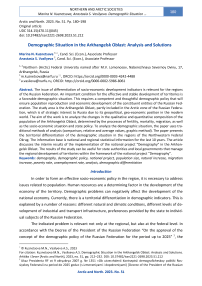Demographic Situation in the Arkhangelsk Oblast: Analysis and Solutions
Автор: Kuznetsova M.N., Vasilyeva A.S.
Журнал: Arctic and North @arctic-and-north
Рубрика: Northern and arctic societies
Статья в выпуске: 51, 2023 года.
Бесплатный доступ
The issue of differentiation of socio-economic development indicators is relevant for the regions of the Russian Federation. An important condition for the effective and stable development of territories is a favorable demographic situation. This requires a competent and thoughtful demographic policy that will ensure population reproduction and economic development of the constituent entities of the Russian Federation. The study area is the Arkhangelsk Oblast, partly included in the Arctic zone of the Russian Federation, which is of strategic interest to Russia due to its geopolitical, geo-economic position in the modern world. The aim of the work is to analyze the changes in the qualitative and quantitative composition of the population of the Arkhangelsk Oblast, determined by the processes of fertility, mortality, migration, as well as the socio-economic situation and state policy. To analyze the demographic situation, the paper uses traditional methods of analysis (comparison, relative and average values, graphic method). The paper presents the territorial differentiation of the demographic situation in the regions of the Northwestern Federal Okrug. The information base is national and regional statistical information for the last 10 years. The article discusses the interim results of the implementation of the national project “Demography” in the Arkhangelsk Oblast. The results of the study can be useful for state authorities and local governments that manage the regional development of territories within the framework of the national project “Demography”.
Demography, demographic policy, national project, population size, natural increase, migration increase, poverty rate, unemployment rate, analysis, demographic differentiation
Короткий адрес: https://sciup.org/148329302
IDR: 148329302 | УДК: 314.15(470.11)(045) | DOI: 10.37482/issn2221-2698.2023.51.212
Текст научной статьи Demographic Situation in the Arkhangelsk Oblast: Analysis and Solutions
In order to form an effective socio-economic policy in the region, it is necessary to address issues related to population. Human resources are a determining factor in the development of the economy of the territory. Demographic problems can negatively affect the development of the national economy. Currently, there is a territorial differentiation in demographic indicators. This is explained by a number of reasons: different natural and climatic conditions, different levels of development of industrial and transport infrastructure, preferences provided by the state to individual subjects of the Russian Federation.
The indicated problem is relevant not only at the regional, but also at the federal level. In accordance with the Decree of the President of the Russian Federation “On the approval of the concept of the demographic policy of the Russian Federation for the period up to 2025” 1, the
-
∗ © Kuznetsova M.N., Vasilyeva A.S., 2023
main guidelines are improvement of the quality of life, stabilization and subsequent growth of the population, and increase of life expectancy. The implementation of the demographic policy is carried out in stages. According to the proposed concept, the third stage is currently being carried out, which consists in consolidating positions and leveling the impact of negative factors. The forecast figures of this document do not differ from the data presented in the population forecast until 2035 2.
According to the Federal State Statistics Service of the Russian Federation, the population of the country in 2025 will be 144 million people in the pessimistic scenario and 147.4 million people in the optimistic scenario. Life expectancy is 74.21 years and 77.38 years, respectively, the total fertility rate is 1.28 and 1.605, respectively 3.
In order to solve the demographic problems, the national project “Demography” is being actively implemented both at the federal 4 and regional levels 5. As part of the implementation of this project, five projects have been developed aimed at supporting families, promoting employment, helping the older generation, health improvement and sports.
Many researchers are addressing the issue of studying demographic processes. This topic is relevant, since population decline can become a long-term barrier to the development of the national economy (regional economy). The deterioration of the demographic situation in the Russian Federation and the constituent entities of the Russian Federation, the problem of migration is becoming of great importance for most regions and the Russian Federation as a whole.
Analysis and assessment of the demographic situation are presented in the works of the following authors [1, 2–12].
In [9, Simonov S.N., Bukina V.M., Simonova D.L., pp. 85–95], the authors noted that the demographic situation is characterized not only by quantitative indicators that assess the state of the population (number, birth rate, mortality, migration, life expectancy), but also by qualitative indicators (level of education, culture, health, professional skills). The authors paid special attention to medical and demographic factors, since they believe that it is the level of health care that to a greater extent characterizes the indicators of population reproduction and their dynamics.
In order to study and analyze demographic processes, not only traditional demography, which considers the patterns of reproduction and population migration, but also the concept of “digital demography” are currently used. Smirnov A.V. clarified the term “digital demography” and proposed to forecast migration processes based on data obtained from social networks [11, p. 135].
The article [12, Trynov A.V., Kostina S.N., Bannykh G.A., p. 810] studied theoretical approaches to the investigation of the influence of factors on fertility. The authors proposed a model of the relationship between the birth rate and socio-economic factors, such as real money income, unemployment rate, marriage rate, life expectancy, etc.
In works [7, 13, 14, 15, 16, 18], the authors focus on the issues of longevity, migration of the population of the European North, Siberia and the Far East.
Particular interest in these territories is explained by the fact that they are fully or partially part of the Arctic zone of the Russian Federation, which has a favorable geopolitical position, enormous hydrocarbon reserves and biological resources (more than 80% of combustible natural gas and 17% oil) 6.
Taking into account the role of the Arctic zone at the federal level, a number of documents was developed that form the state policy of the Russian Federation for the time period up to 2035 7 and the strategic development of the territory up to 2024 8. As part of the Strategy, the state program “Socio-economic development of the Arctic zone of the Russian Federation” is being implemented, which focuses on increasing the level of socio-economic development of the Arctic zone of the Russian Federation by creating 13.274 jobs, increasing life expectancy, reducing migration outflow and decreasing unemployment rate 9. In each subject of the Russian Federation belong- ing to the Arctic zone, documents are being developed at the mesolevel, taking into account the characteristics of the region. Monitoring of the Arctic in terms of key economic indicators is also presented in foreign sources 10.
The development of territories is impossible without a well-thought-out demographic policy, which contributes to the effective functioning of the subject.
Analysis of the demographic situation in the Arkhangelsk Oblast
The study area is the Arkhangelsk Oblast, which is partially included in the Arctic zone of the Russian Federation (the municipality “Arkhangelsk City”, the municipality “Mezenskiy municipal district”, the municipality of the urban district “Novaya Zemlya”, the municipality “Novodvinsk City”, the municipality “Onega municipal district”, the municipal formation “Primorskiy municipal district”, the urban district “Severodvinsk”, the municipal formation “Leshukonskiy municipal district”, the municipal formation “Pinezhskiy municipal district”). The Arkhangelsk Oblast belongs to the Far North and equated areas.
The region is rich in bioresources, which predetermines the developed infrastructure of forestry, woodworking and fish processing complexes. Large shipbuilding and ship repair enterprises are located on the territory of the region; diamonds, bauxite and limestone deposits are being developed and effectively exploited. Accordingly, this predetermines the scope of employment of the Oblast population and the development of certain industries.
The population of the Arkhangelsk Oblast has negative dynamics: every year it decreases by 0.6–1.02% (Fig. 1). In the period under review, the population decreased by 110.44 thousand people. A decrease in the rate of population decline is observed from 2014 to 2017 and from 2019 to 2020 (by 0.6–0.7%). The highest rate is observed from 2010 to 2011 — by 1.019% or by 12.6 thousand people.
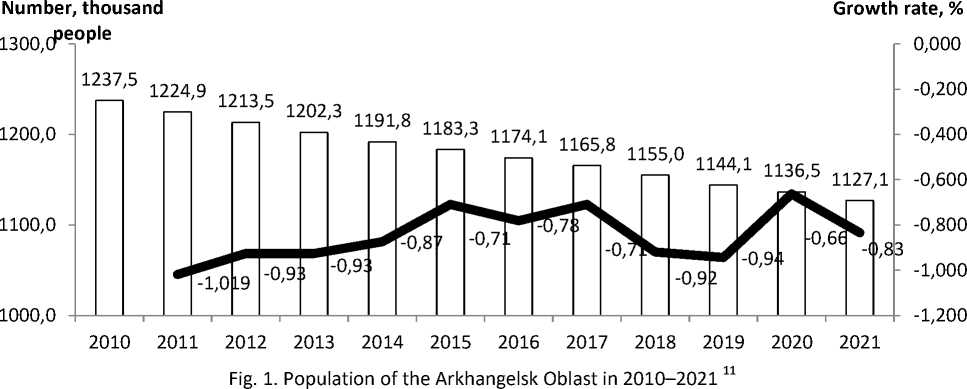
economic development of the Arctic zone of the Russian Federation” dated March 30, 2021 No. 484 (as amended on October 30, 2021)]. URL: (accessed 16 June 2022).
10 Arctic Monitoring and Assessment Programme (AMAP). Oslo, 2017. 280 p.
11 Compiled by the authors. Source: Federal State Statistics Service data. URL: (accessed 16 June 2022).
This situation has a negative impact on the socio-economic indicators of the territory, does not allow the effective development of the region, which belongs to a strategically significant territory, is of interest to Russia and the world community, based on geopolitical, geo-economic positions in the modern world.
The dynamics of population decline is observed both in the number of men and women (Fig. 2). The number of men over the past 6 years has decreased by 25.45 thousand people (from 553.91 thousand to 528.46 thousand), women — by 30.83 thousand people (from 629.42 thousand to 598.59 thousand).
It should be noted that the number of women every year is on average 70 thousand people more than the number of men.
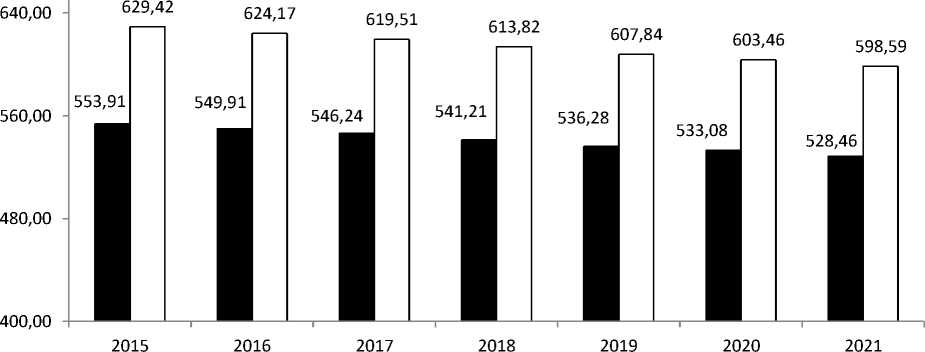
■ males □ females
Fig. 2. Number of men and women in the Arkhangelsk Oblast in 2015–2021, thousand people 12.
According to the average forecast of Rosstat, the number of men in the Arkhangelsk Oblast over the next 10 years will decrease by another 40.55 thousand people (by 7.72%), women — by 54.51 thousand people (by 9.21%).
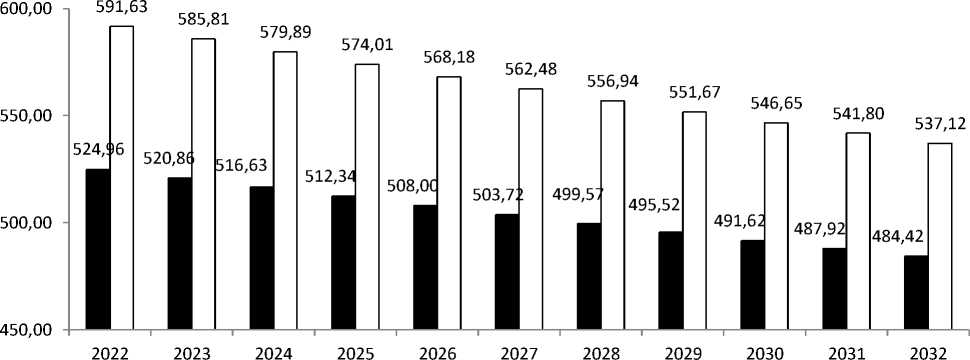
■ males □ females
Fig. 3. Average forecast for the number of men and women in the Arkhangelsk region in 2022–2032, thous. people 13
The age structure of the population of the Arkhangelsk Oblast (Table 1) has practically not changed over the period under review. Insignificant structural shifts of 1–3% towards an increase (decrease) in certain age categories are observed.
Table 1
The structure of the population of the Arkhangelsk Oblast by age 14
|
Age |
2015 |
2022 |
Structure change, % |
||
|
Number, people |
Share, % |
Number, people |
Share, % |
||
|
total |
1 183 323 |
100 |
1114322 |
100 |
- |
|
0–4 |
74 613 |
6.31 |
51768 |
4.65 |
-1.66 |
|
5–9 |
68 593 |
5.80 |
71478 |
6.41 |
0.62 |
|
10–14 |
61 483 |
5.20 |
69999 |
6.28 |
1.09 |
|
15–19 |
54 806 |
4.63 |
61876 |
5.55 |
0.92 |
|
20–24 |
63 619 |
5.38 |
53684 |
4.82 |
-0.56 |
|
25–29 |
93 877 |
7.93 |
55662 |
5.00 |
-2.94 |
|
30–34 |
96 858 |
8.19 |
76947 |
6.91 |
-1.28 |
|
35–39 |
92 921 |
7.85 |
91294 |
8.19 |
0.34 |
|
40–44 |
81 106 |
6.85 |
87419 |
7.85 |
0.99 |
|
45–49 |
73 675 |
6.23 |
81296 |
7.30 |
1.07 |
|
50–54 |
89 623 |
7.57 |
67424 |
6.05 |
-1.52 |
|
55–59 |
94 876 |
8.02 |
72813 |
6.53 |
-1.48 |
|
60–64 |
82 606 |
6.98 |
82793 |
7.43 |
0.45 |
|
65–69 |
52 868 |
4.47 |
74350 |
6.67 |
2.20 |
|
over 70 |
101 799 |
8.60 |
115519 |
10.37 |
1.76 |
The structure of the population in the context of the main age groups is stable (Table 2). 25% of the population are people over working age. Slightly less than this indicator (18–19%) are children and adolescents younger than working age. The main share, more than 56%, is people of working age.
Table 2
Composition and structure of the population of the Arkhangelsk Oblast by age groups 15
|
Indicator |
2015 |
2022 |
Structure change, % |
||
|
Number, people |
Share, % |
Number, people |
Share, % |
||
|
Total |
1 183 323 |
100 |
1 114 322 |
100 |
- |
|
Younger than able-bodied |
215 250 |
18 |
205 646 |
19 |
1 |
|
Able-bodied |
677 513 |
57 |
625 689 |
56 |
-1 |
|
Older than ablebodied |
290 500 |
25 |
282 987 |
25 |
0 |
Despite the preservation of the structure, analysis of the dynamics of the absolute values of these indicators indicates that the number of able-bodied population has decreased over the past 7 years the most — by 51.9 thousand people (7.66%). The decrease in the number of people younger than working age was 9.6 thousand people (4.46%), and older than working age — 7.5 thousand people (2.59%).
According to the average forecast of Rosstat, the working-age population of the Arkhangelsk Oblast will not change in the next 10 years (Fig. 4). However, the number of children and adolescents younger than working age will decrease by 57.6 thousand people (by 27.9%), and the number of people older than working age — by 38.0 thousand people (by 13.2%).
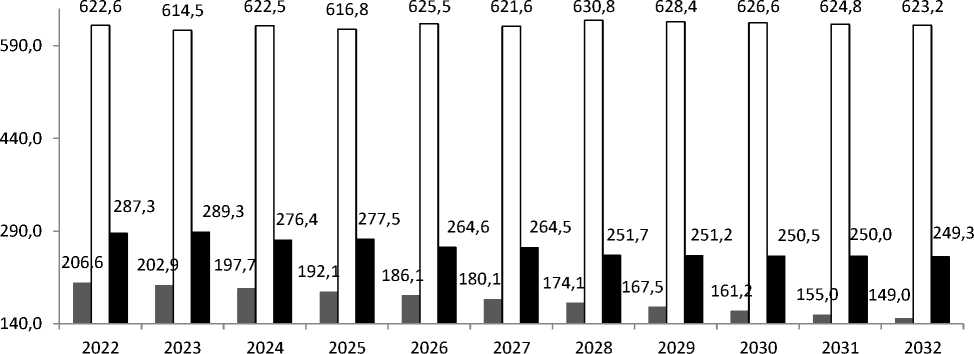
■ younger than able-bodied
□ able-bodied
■ older than able-bodied
Fig. 4. The average version of the population forecast for the Arkhangelsk Oblast in 2022–2032, thousand people 16.
-
15 Compiled by the authors. Source: Federal State Statistics Service data. URL: https://rosstat.gov.ru/ (accessed 30 June 2022).
-
16 Compiled by the authors. Source: Federal State Statistics Service data. URL: https://rosstat.gov.ru/ (accessed 30 June 2022).
For the entire period under review, the death rate in the region exceeds the birth rate, this trend has been negative since 2013 (Fig. 5). The natural loss per 1000 people over the past 8 years has increased from 0.5 to 9.6.
More often, the inhabitants of the region die from diseases of the circulatory system — about 7 thousand people annually. Statistical observations show that in the region in 2020, mortality from respiratory diseases (by 24%), infectious and parasitic diseases (by 4.3%), diseases of the digestive system (by 4.1%), neoplasms (by 0 .7%) increased. This is due to the unfavorable northern climatic conditions, the low income of the population and the inability to provide adequate nutrition and recreation.

Fig. 5. Natural population decline in the Arkhangelsk Oblast in 2011–2021 per 1000 people 17.
A comparative analysis of the urban and rural population showed that the size of both categories of the population is decreasing, and the rural population is declining faster: in the period from 2015 to 2021, the rural population decreased by 34.3 thousand people, and the urban population — by 21.9 thousand people. The gap between the urban and rural population increased over the period under review from 3.34 to 3.73 times (Fig. 6).
-
17 Compiled by the authors. Source: Federal State Statistics Service data. URL: https://rosstat.gov.ru/ (accessed 01 July
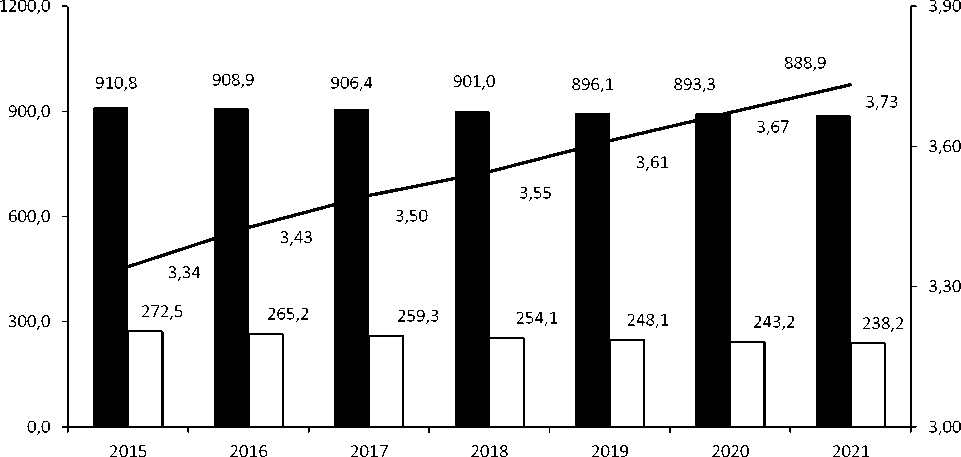
^ urban population, thousand people
^^^^^м excess urban / rural, times rural population, thousand people
Fig. 6. Urban and rural population of the Arkhangelsk Oblast in 2010–2021 18.
Over the past 10 years, there has been an active outflow of residents from rural areas (Fig. 7). Peaks (from -6.5 to 7.0 thousand people) were recorded in 2011–2012 and 2014, when significant political and economic events took place in the country. The population in rural areas is actively declining, which is associated with low standard of living, unfavorable climatic conditions for the development of animal husbandry and agriculture. A slight revival occurs in the summer period, when there is an increase in the population of villages due to vacationers and children leaving the city for holidays.
The population of cities is declining less actively due to the departure of northerners to other regions. The main reasons for migration are the change of place of residence to a region with a more favorable climate and higher standard of living, as well as the relocation of school graduates due to enrolment in the country’s leading universities. The peaks of migration loss of the urban population are observed in 2013 and 2017: -4.2 thousand people and -4.5 thousand people, respectively. In the past two years, the migration movement of the urban population has acquired a positive trend: in 2020, the increase amounted to +0.4 thousand people, in 2021 — +1.0 thousand people. This is largely due to the employment of specialists from other regions at large enterprises of the region (for example, at JSC Sevmash, JSC Zvezdochka).
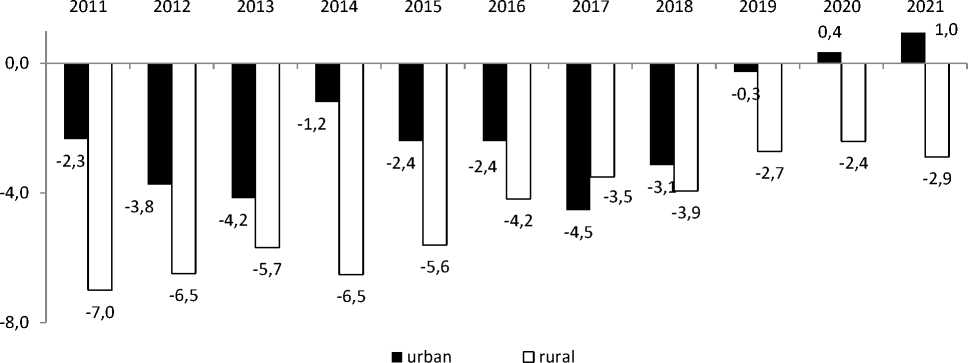
Fig. 7. Migration increase/decrease in the Arkhangelsk Oblast in 2011–2021, thousand people 19.
In 2021, 3.4 thousand males and 3.3 thousand females younger than working age left the region. The outflow of the able-bodied population exceeded these figures by 4 times: 13.2 thousand men and 14.3 thousand women. As a result, as can be seen from Fig. 8, the migration loss of women of working age amounted to 942 people. For men of working age, there is a migration influx, which, as noted above, is mainly associated with employment at large enterprises in the region (for example, JSC “United Shipbuilding Corporation”). The migration outflow of people older than working age is explained by the change of residence after retirement.
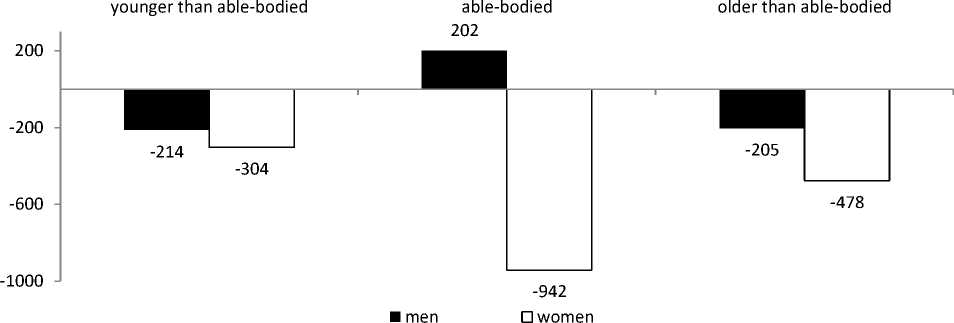
Fig. 8. Migration increase/decrease in the Arkhangelsk Oblast in 2021, people 20.
The outflow of the population from the Arkhangelsk Oblast, as noted above, is partly due to the population moving to regions with higher incomes. Thus, in 2021, the average per capita income of the population of the Arkhangelsk Oblast was 2.71 times higher than the subsistence minimum, which is 1.27 times lower than the average Russian level and 1.77 times lower than in St. Petersburg (Fig. 9). According to this indicator, the Arkhangelsk Oblast is in fourth place among the regions of the North-West Federal District.
-
19 Compiled by the authors. Source: Federal State Statistics Service data. URL: https://rosstat.gov.ru/ (accessed 01 July 2022).
-
20 Compiled by the authors. Source: Federal State Statistics Service data. URL: https://rosstat.gov.ru/ (accessed 01 July 2022).
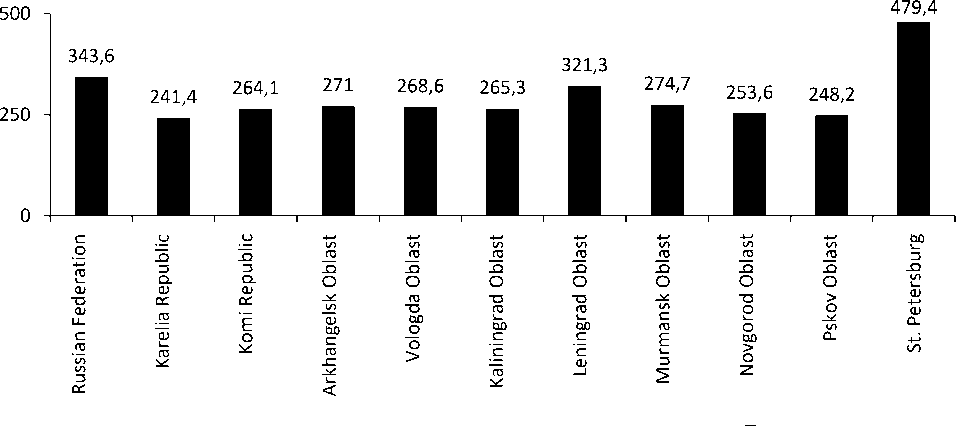
Fig. 9. Ratio of average per capita cash income with the subsistence minimum in the Russian Federation and in the regions of the North-West Federal District in 2021, % 21.
In 2021, the Arkhangelsk Oblast ranks fifth among the NWFD in terms of the “share of the population with cash incomes below the poverty line”. This figure is 12.5% (Fig. 10) and exceeds the national average by 1.5%.
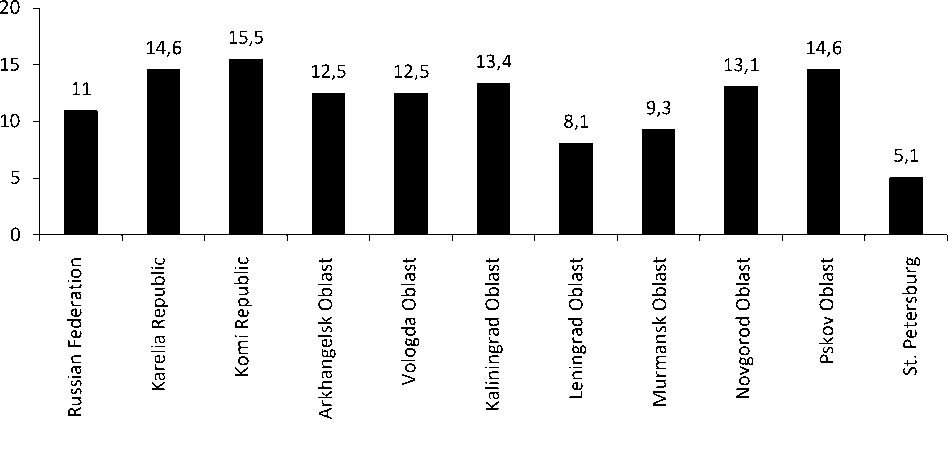
Fig. 10. Share of the population with cash incomes below the poverty line in the Russian Federation and in the regions of the North-West Federal District in 2021, % 22.
The low income level for the northern region led to the fact that the unemployment rate in the Arkhangelsk Oblast in 2021 exceeded the average Russian indicator by 1.38 times and by 3.3 times the level in St. Petersburg, ranking second in the North-West Federal District (Fig. 11).
-
21 Compiled by the authors. Source: Federal State Statistics Service data. URL: https://rosstat.gov.ru/ (accessed 02 July 2022).
-
22 Compiled by the authors. Source: Federal State Statistics Service data. URL: https://rosstat.gov.ru/ (accessed 02 July 2022).
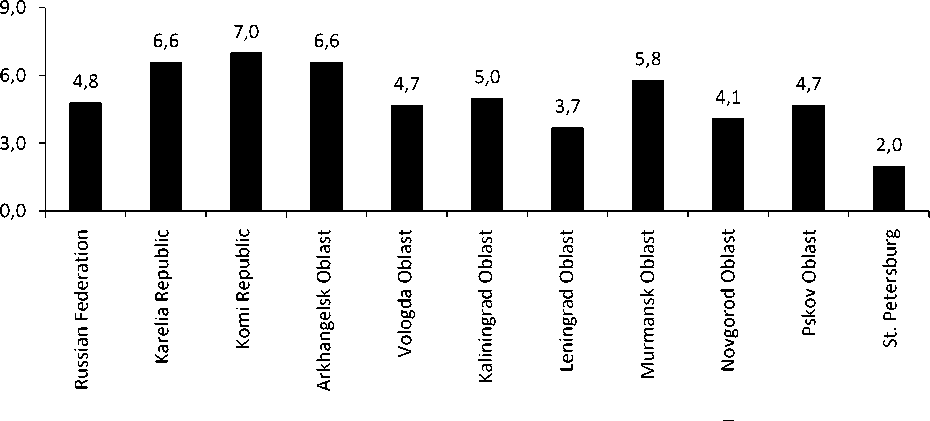
Fig. 11. Unemployment rate in the Russian Federation and in the regions of the NWFD in 2021, % 23.
In order to study the territorial differentiation of the demographic situation in the NorthWest Federal District, Table 3 was formed, which presents summary information on the size and composition of the population, on general indicators of population reproduction: fertility, mortality, migration.
Table 3
Summary of key demographic indicators for 2021 24
|
Region |
_ CL с о ° я +3 °-го тз 3 С Q-О 3 °- о |
га S' И £ го ГО CD |
ч= О 'о U О CD 5 £ о. га с |
±f Q. с о о — о. |
и йЬ О СР •3 ^ S 2 оз |
|
Republic of Karelia |
609.1 |
69.6 |
1.4 |
4.4 |
-0.8 |
|
Komi Republic |
813.6 |
70.3 |
1.6 |
2.3 |
-41.7 |
|
Arkhangelsk Oblast |
1 127.1 |
71.4 |
1.4 |
3.4 |
-20.6 |
|
Vologda Oblast |
1 151.0 |
70.7 |
1.5 |
5.5 |
-17.8 |
|
Kaliningrad Oblast |
1 018.7 |
72.9 |
1.4 |
3.8 |
101.1 |
|
Leningrad Oblast |
1 892.7 |
71.5 |
1.1 |
3.9 |
168.0 |
|
Murmansk Oblast |
732.9 |
69.8 |
1.5 |
3.8 |
-69.2 |
|
Novgorod Oblast |
592.4 |
69.6 |
1.4 |
4.1 |
31.9 |
|
Pskov Oblast |
620.2 |
69.1 |
1.4 |
4.0 |
16.7 |
-
23 Compiled by the authors. Source: Federal State Statistics Service data. URL: https://rosstat.gov.ru/ (accessed 02 July 2022).
-
24 Compiled by the authors. Source: Federal State Statistics Service data. URL: https://rosstat.gov.ru/ (accessed 31 October 2022).
The data presented in Table 3 show that the Arkhangelsk Oblast:
-
• in terms of population: ranks second in the NWFD, behind the Leningrad and Vologda Oblasts. However, it is necessary to take into account the differences in territorial areas and population density (for example, the Kaliningrad Oblast — 15.125 sq. km, population density — 68.1 people per 1 km2, Arkhangelsk Oblast — 589.913 sq. km, population density — 1.73 people per 1 km2);
-
• in terms of life expectancy: the third place in the presented list of regions. The lowest values of the indicator are observed in the Republic of Karelia (69.6 years), Murmansk (69.8 years), Novgorod (69.6 years), Pskov oblasts (69.1 years);
-
• in terms of infant mortality: the second place in the ranking (3.4 per 1000 people). This indicates that the level of medical services provided to pregnant women is higher than in other areas;
-
• in terms of the migration growth rate, the situation is critical (-20.6). The studied region is an outsider, the Republic of Komi (-41.7) and the Murmansk Oblast (-69.2) are behind.
The analysis of the demographic situation showed that there is a negative trend. Negative demographic changes occur due to natural population decline, migration processes, adverse climatic conditions, low incomes and high unemployment.
Implementation of the national project “Demography” in the Arkhangelsk Oblast
The main reasons for the decrease in the number of residents of the Arkhangelsk Oblast are natural losses. The generation of the 1990s, early 2000s is in working and reproductive age. As a result, despite the ongoing policy in the field of changing the demographic situation, the outlined guidelines are becoming difficult to implement.
The decline in the birth rate is sustainable, determined by objective changes (aging of the population, decrease in the number of women of reproductive age). Negative impact on natural population decline in 2020–2021 had an unfavorable epidemiological situation (COVID-19).
Currently, there is a steady decline in the share of migration loss of the population. In 2021, the share of migration outflow in the structure of the total population loss decreased to 16.1%. In 2017, this figure was 72.5%, in 2018 — 62.4%, in 2019 — 39%, in 2020 — 25.3%. The reduction of migration mobility and the decrease in population outflow in 2020–2021 was influenced by the epidemiological situation in large cities of the Russian Federation, which are attractive for the residents of the Arkhangelsk Oblast.
In order to reduce the population decline in the Arkhangelsk Oblast, it is necessary to pay attention to improving the standard of living and quality of life of population in order to reduce the migration outflow to other regions of the Russian Federation, increase the birth rate and reduce mortality. This will stabilize the population.
At the regional level, a number of state programs related to improving the quality of life have been developed: “Social support for citizens in the Arkhangelsk Oblast” (includes 7 subpro- grams) 25, “Promotion of employment in the Arkhangelsk Oblast, improvement of working conditions and labor protection” (5 subprograms) 26, “Ensuring quality, affordable housing and engineering infrastructure facilities for the population of the Arkhangelsk Oblast” (3 subprograms) 27. The responsible executor of state programs in the field of social support and employment of the population is the Ministry of labor, employment and social development of the Arkhangelsk Oblast, in the field of providing high-quality, affordable housing — the Ministry of construction and architecture of the Arkhangelsk Oblast.
The integral assessment of the effectiveness of the programs listed above in 2020 was 82.2 (medium), 85.4 (medium), 92.2 (high), respectively. In 2021, these indicators have not changed significantly and are equal to 86.4 (medium), 91.0 (high), 91.5 (high). The presented values of program effectiveness indicators demonstrate that attention should be paid to the first two programs that directly affect the quality of life of the population. The implementation of these programs in 2020-2021 was significantly affected by restrictive measures resulting from the current unfavorable epidemiological situation (COVID-2019).
It should be noted that when calculating the integral assessment of the effectiveness of the implementation of any of the listed programs, the largest share falls on the assessment of the implementation of the program by performers — 0.8. The assessment of the quality of planning and management of the implementation of the state program has the smallest weight — 0.2. The authors of the study believe that the effectiveness of program implementation depends on the quality of planning indicators in the future, so it is worth adjusting the weights in the direction of reducing the value of the first indicator and increasing the last one. Such a change will make it possible to formulate correct conclusions about the effectiveness of a particular program.
According to the forecast for the socio-economic development of the Arkhangelsk Oblast for 2022–2024 28, it is assumed that the population of the region (excluding NAO) will decrease by 8.8 thousand people per year in the baseline scenario, and by 10.15 thousand people per year in the conservative scenario. Life expectancy increases by 0.65 years on average in the baseline scenario, and by 0.1 years in the conservative scenario. Total fertility and mortality rates in the baseline and conservative scenarios decrease by 0.4 and 0.25, 0.33 and 0.2 respectively. The decrease in the total mortality rate is a positive trend. The projected migration balance for the period of 2022 and 2024 decreases and reaches -2530 people (baseline scenario) and -2890 people (con- servative scenario) in 2024. These values indicate that measures to improve the standard of living and quality of life in the region are insufficient.
In order to stabilize the demographic situation in the region, within the framework of the national project “Demography”, the Arkhangelsk Oblast participates in 5 projects that are aimed at financial support for families at the birth of children, increasing employment, supporting the older generation, improving health, and developing sports. For each direction, a regional project passport has been developed 29, which indicates the main provisions, results and financial support of the project, the relationship with government programs aimed at improving the level and quality of life in the region.
One of the most important projects is financial support for families at the birth of children (monthly payments at the birth of the third and subsequent children under the age of 3 years, monthly payments to low-income families at the birth of the first child, free in vitro fertilization of women diagnosed with infertility, one-time payments to women who gave birth to their first child between the ages of 18 and 25, social support for large families in the form of compensation for utility bills, indexation of maternity capital). In addition, conditions are being created for women to enable them to return to work more quickly after the birth of child (creation of additional places in preschool institutions, career guidance for women during maternity leave, etc.). Such measures should help to improve the demographic situation and increase the birth rate in the region.
In the Arkhangelsk Oblast, special attention is paid to increasing life expectancy. For this purpose, people are motivated to a healthy lifestyle, active sports. Within the framework of the regional project (sport development), it is planned to build at least 6 sports and recreation complexes, sports facilities, purchase sports equipment and inventory for 2 sports schools. The regional project (health promotion) is aimed at creating public health centers, developing and implementing corporate programs to improve the health of workers at enterprises. Such measures make it possible to increase life expectancy and the period of active longevity, and to reduce mortality rates. This has a positive effect on a person’s ability to be in demand by society and the labor market.
Support for the older generation becomes a priority and is aimed at medical and social assistance to people over 65 (leisure, retraining, home care, volunteering). In the Arkhangelsk Oblast, in order to improve the availability and quality of medical and sanitary services for the elderly, the following were created: 12 paramedic and paramedic-obstetric stations, medical outpatient clinics, a unified regional emergency medical dispatch system, a regional geriatric center to provide medical care to elderly and disabled people. This improves the quality of life of this category of the population, increases their life expectancy.
Monitoring of the implementation of the national project “Demography” in the region is presented on the portal of the Government of the Arkhangelsk Oblast in the section “Information on the implementation of national projects” (reference of documents) in the form of reports for each of the five projects, divided by quarters and indicators (results, milestones, budget implementation). In 2021, the results of the national project “Demography”: “Social support for citizens in the Arkhangelsk Oblast” — 81% (20 out of 105 activities were not implemented), “Providing high-quality, affordable housing and engineering infrastructure facilities for the population of the Arkhangelsk Oblast” — 94.7% (1 out of 19 activities was not implemented), “Promotion of employment in the Arkhangelsk Oblast, improvement of working conditions and labor protection” — 86.0% (6 out of 43 activities were not implemented). These figures testify to the effective work within the framework of the national project.
The work on changing the demographic situation is also carried out at the municipal level. Each municipality of the Arkhangelsk Oblast (21 municipalities) formed a passport of the municipal project for the period from 2019 to 2024, where the main provisions are written (goal, objectives, project indicators by years, calendar plan, risks, sources of funding).
The target indicators for improving the demographic situation in municipal projects are: the proportion of the population systematically involved in physical culture and sports, the creation of additional places in preschool institutions, the number of young families who received certificates for the purchase of housing, the number of activities aimed at conducting preventive medical examinations , general mortality rate per 1.000 people, mortality rate of the working-age population per 100.000 people. The list varies by municipality.
The differentiation of target indicators by municipalities for 2022 is presented in Table. 4. A comparative analysis was carried out according to 2 target indicators: “total mortality rate of the population” and “share of the population systematically engaged in physical culture and sports”. Data from municipal passports of municipal entities, which have both indicators, are used for the analysis 30. This allows for data comparability.
Table 4
Target indicators of the demographic situation in the municipalities of the Arkhangelsk Oblast
|
Municipality |
Population mortality per 1.000 people |
Share of population systematically engaged in physical culture and sport, % |
|
Velskiy municipal district |
12.5 |
53.0 |
|
Verkhnetoemskiy municipal district |
20.8 |
47.2 |
|
Kargopolskiy municipal district |
14.9 |
44.5 |
|
Kotlasskiy municipal district |
14.9 |
35.0 |
|
Lenskiy municipal district |
13.9 |
48.5 |
|
Leshukonskiy municipal district |
25.8 |
47.0 |
|
Mezenskiy municipal district |
19.1 |
40.0 |
|
Nyandomskiy municipal district |
13.1 |
47.2 |
|
Plesetskiy municipal district |
16.2 |
47.2 |
30 Compiled by the authors. Document directory. URL: (accessed 06 November 2022).
|
Ustyanskiy municipal district |
17.2 |
56.6 |
|
Kholmogorskiy municipal district |
18.1 |
35.0 |
The data presented in Table 4 indicate that:
-
• the highest mortality rate per 1.000 people is expected in Leshukonskiy municipal district (25.8), Verkhnetoemskiy municipal district (20.8), Mezenskiy municipal district (19.1). The reason: remoteness of the districts from the regional center, inaccessibility (lack of logistics), high percentage of the population of the older generation;
-
• the leaders in terms of the “share of population systematically engaged in physical culture and sports” are Ustyanskiy municipal district (56.6%), Velskiy municipal district (53%), Lenskiy municipal district (48.5%). The high values of the target indicator in the Ustyanskiy municipal district and the Velskiy municipal district are explained by the proximity to the Malinovka ski center, the active development of the sports infrastruc-
- ture;
-
• several municipal districts have a value of 47.2% for the indicator “share of population systematically engaged in physical culture and sports”. These are Verkhnetoemskiy municipal district, Nyandomskiy municipal district, Plesetskiy municipal district. It should be noted that the Verkhnetoemskiy municipal district has the highest mortality rate, but at the same time, in this territory, the emphasis is on increasing the proportion of people involved in sports, leading an active lifestyle;
-
• outsiders in terms of the “share of population systematically engaged in physical culture and sports” are Kotlasskiy municipal district (35%), Kholmogorskiy municipal district (35%). This indicates that it is necessary to carry out motivational work among the population, promote a healthy lifestyle and active sports, and create conditions for the development of infrastructure there.
Achievement of target indicators is carried out at the expense of the actions specified in municipal projects. Currently, there are no reports on the implementation of municipal projects on the portal of the Government of the Arkhangelsk Oblast. Therefore, there is no possibility to assess the effectiveness of projects.
Thus, the demographic problem in the region does not remain unattended. Currently, the national project “Demography” is being actively implemented in 5 areas. Based on the federal project, the implementation of regional projects is carried out on the territory of the Arkhangelsk Oblast, which in turn are the basis for the formation of municipal projects.
Conclusion
The object of study is the Arkhangelsk Oblast, which is partially included in the Arctic zone of the Russian Federation and is of strategic interest for Russia based on the geopolitical and geo-economic positions of the region in the modern world.
The paper analyzes the changes in the qualitative and quantitative composition of the population of the Arkhangelsk Oblast, determined by the processes of fertility, mortality, migration, as well as the socio-economic situation and state policy.
Traditional methods are used to analyze the demographic situation. A comparative analysis of the demographic situation in the regions of the North-West Federal District showed that the Arkhangelsk Oblast is an outsider in terms of the migration growth rate. For other indicators, the region occupies an intermediate value in the list of subjects that are part of the NWFD.
It should be noted that the demographic problem in the region is not neglected. The interaction of all levels of government ensures the effectiveness of measures aimed at improving the demographic situation (increase in the birth rate, decrease in mortality, increase in life expectancy, migration population growth) and at improving the quality of life.
The results of the study can be useful for public authorities and local governments that manage the regional development of territories within the framework of the national project “Demography”.
Список литературы Demographic Situation in the Arkhangelsk Oblast: Analysis and Solutions
- Babich S.G., Yarnykh E.A. Analiz sovremennoy demograficheskoy situatsii v Rossiyskoy Federatsii [Analysis of the Current Demographic Situation in the Russian Federation]. Ekonomicheskie nauki [Economic Sciences], 2018, no. 9 (166), pp. 141–150.
- Vasilyeva E.V., Vasileva A.V. Demograficheskie issledovaniya v kontekste potentsiala razvitiya i ekonomicheskoy bezopasnosti territorii [Demographic Research in the Context of Economic Devel-opment and Security of Regions]. Ekonomika regiona [Economy of Regions], 2022, vol. 18, no. 1, pp. 1–20. DOI: 10.17059/ekon.reg.2022-1-1
- Kashepov A.V. Metodologiya i praktika analiza sovremennoy demograficheskoy situatsii [Methodol-ogy and Practice of Analyzing the Current Demographic Situation]. Aktual'nye problemy gumani-tarnykh i estestvennykh nauk [Actual Problems of Humanities and Natural Sciences], 2018, no. 12, pp. 35–47.
- Nizamutdinov M.M., Oreshnikov V.V. Modelirovanie i otsenka vliyaniya urovnya razvitiya sotsi-al'noy infrastruktury na dinamiku smertnosti i prodolzhitel'nost' zhizni naseleniya v regionakh Rossii [Modeling and Evaluation of the Impact of the Level of Social Infrastructure Development on the Dynamics of Mortality and Life Expectancy in the Regions of Russia]. Region: Ekonomika i Sotsiologiya [Region: Economics and Sociology], 2021, no. 4 (112), pp. 208–230. DOI: 10.15372/REG20210408
- Novak M.A., Kozlova E.I. Retrospektivnyy i perspektivnyy analiz demograficheskoy situatsii v Li-petskoy oblasti [Retrospective and Prospective Analysis of the Demographic Situation in the Lipetsk Region]. Vestnik Belgorodskogo universiteta kooperatsii, ekonomiki i prava [Herald of the Belgorod University of Cooperation, Economics and Law], 2019, no. 1 (74), pp. 166–181.
- Popova L.A. Smertnost' rossiyskogo naseleniya po prichinam smerti: tendentsii urovnya, gendernye i mezhposelencheskie razlichiya [Russian Population Mortality by Cause of Death: Level Trends, Gender and Inter-Urban Disparities]. Region: Ekonomika i Sotsiologiya [Region: Economics and So-ciology], 2021, no. 4 (112), pp. 183–207. DOI: 10.15372/REG20210407
- Provorova A.A., Gubina O.V. Ozhidaemaya prodolzhitel'nost' zhizni v rossiyskoy Arktike: region-al'nye osobennosti i rezervy rosta [Life Expectancy in the Russian Arctic: Regional Features and Growth Reserves]. Arktika: ekologiya i ekonomika [Arctic: Ecology and Economy], 2022, vol. 12, no. 1, pp. 6–18. DOI: 10.25283/2223-4594-2022-1-6-18
- Sapunov A.V., Sapunova T.A., Bagyan G.A. Analiz aktual'noy demograficheskoy situatsii v Rossiyskoy Federatsii [Analysis of the Current Demographic Situation in the Russian Federation]. Estestvenno-gumanitarnye issledovaniya [Natural-Humanitarian Studies], 2021, no. 33 (1), pp. 187–190. DOI: 10.24412/2309-4788-2021-10854
- Simonov S.N., Bukina V.M., Simonova D.L. Metodicheskie podkhody k analizu mediko-demograficheskoy situatsii v regione [Methodological Approaches to the Analysis of the Medical and Demographic Situation in the Region]. In: Teoreticheskie i prikladnye aspekty sovremennoy nauki. Seriya: estestvenno-tekhnicheskaya. Sbornik nauchnykh trudov [Theoretical and Applied As-pects of Modern Science. Series: Natural-Technical. Collection of Scientific Papers], 2015, pp. 85–95. (In Russ.)
- Smirennikova E.V., Ukhanova A.V., Voronina L.V. Otsenka demograficheskogo potentsiala arktich-eskikh regionov Rossiyskoy Federatsii v kontekste innovatsionnogo razvitiya [Assessment of the Demographic Potential of the Arctic Regions of the Russian Federation on the Context of Innovative Development]. Arktika: ekologiya i ekonomika [Arctic: Ecology and Economy], 2021, vol. 11, no. 1, pp. 19–29. DOI: 10.25283/2223-4594-2021-1-19-29
- Smirnov A.V. Prognozirovanie migratsionnykh protsessov metodami tsifrovoy demografii [Digital Demography Methods for Forecasting Migration Processes]. Ekonomika regiona [Economy of Re-gions], 2022, vol. 18, no. 1, pp. 133–145. DOI: 10.17059/ekon.reg.2022-1-10
- Trynov A.V., Kostina S.N., Bannykh G.A. Issledovanie sotsial'no-ekonomicheskoy determinatsii rozh-daemosti na osnove analiza regional'nykh panel'nykh dannykh [Examination of Socio-Economic De-terminants of Fertility Based on the Regional Panel Data Analysis]. Ekonomika regiona [Economy of Regions], 2020, vol. 16, vol. 3, pp. 807–819. DOI: 10.17059/ekon.reg.2020-3-10
- Fauzer V.V., Smirnov A.V. Migratsii naseleniya rossiyskoy Arktiki: modeli, marshruty, rezul'taty [Mi-gration of the Russian Arctic Population: Models, Routes, Results]. Arktika: ekologiya i ekonomika [Arctic: Ecology and Economy], 2020, no. 4 (40), pp. 4–18. DOI: 10.25283/2223-4594-2020-4-4-18
- Fauzer V.V., Smirnov A.V., Lytkina T.S., Fauzer G.N. Vyzovy i protivorechiya v razvitii Severa i Arktiki: demograficheskoe izmerenie [Challenges and Contradictions in the Development of the North and the Arctic: Demographic Dimension]. Arktika: ekologiya i ekonomika [Arctic: Ecology and Economy], 2022, vol. 12, no. 1, pp. 111–122. DOI: 10.25283/2223-4594-2022-1-111-122
- Frolova E.A., Malanina V.A. Indeks aktivnogo dolgoletiya v regionakh Sibiri [Active Ageing Index in Siberian Regions]. Ekonomika regiona [Economy of Regions], 2021, vol. 17, no. 1, pp. 209–222. DOI: 10.17059/ekon.reg.2021-1-16
- Shmidt Yu.D., Ivashina N.V. Otsenka rezul'tativnosti novykh instrumentov migratsionnoy politiki v Dal'nevostochnom regione [Assessment of Migration Policy Measures Implemented in the Russian Far East]. Ekonomika regiona [Economy of Regions], 2021, vol. 17, no. 3, pp. 902–916. DOI: 10.17059/ekon.reg.2021-3-13
- Shulgin S.G., Zinkina Yu.V. Otsenka chelovecheskogo kapitala v makroregionakh Rossii [Assessment of Human Capital in Russian Macroregions]. Ekonomika regiona [Economy of Regions], 2021, vol. 17, no. 3, pp. 888–901.
- Bogoyavlensky D. Demography of the Peoples of the Russian North at the Beginning of the XXI Cen-tury. Medicine of Alaska, 2007, vol. 49, no. 2, pp. 269–272.

